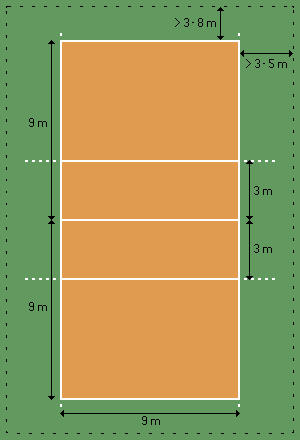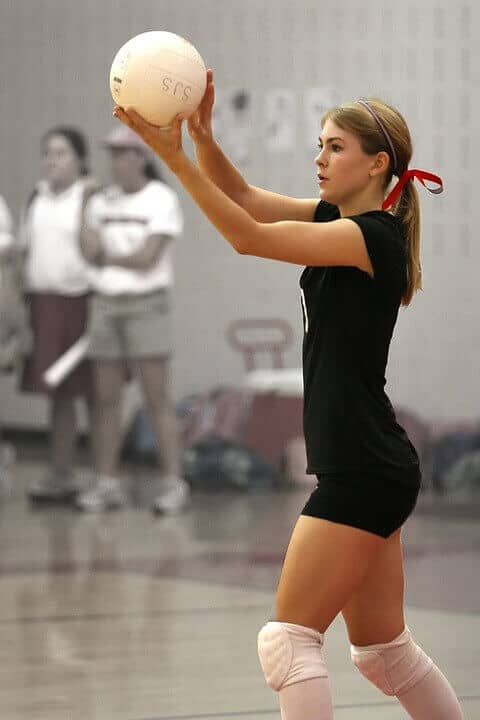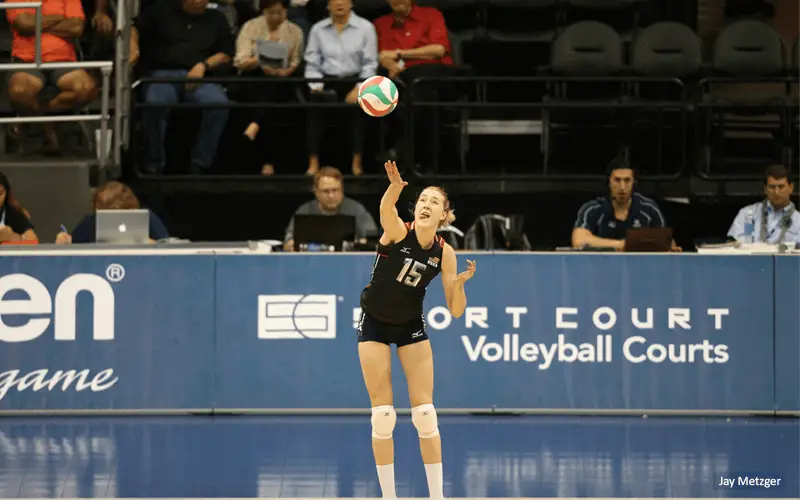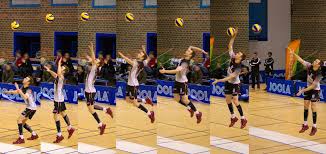The serve in volleyball is a vital part of the game. It signifies the start of every single rally that takes place in the sport.
Mastering the art of serving can give you a massive advantage over your opponents.
A well executed serve can be an easy way to get a few points over your opponents.
Even when playing a very good team a dangerous serve can force your opponents out of system making it harder for the setter and hitters and much easier for your team blocking.
So to master the art of getting aces we first need to look at the serve itself.
In this article I will go over the basics of the serve to assist you if you are a beginner and then I will touch on the different types of serves and associated techniques for the more advanced players.
You will see a contents table below if you are not a beginner you may want to skip right ahead to the advanced serves.
Table of Contents
How To Serve A Volleyball As A Beginner
So before I deep dive into this I will say a quick disclaimer. I am only going to talk about the overhand serve and not the underarm serve.
Prior to serving a volleyball we need to stand in the correct location.
When serving in volleyball you must be behind the back line also known as the service line.

When serving it is important we do not step on the line and stay behind it at all times.
If you step on or pass over the line it will be classed as a foot fault and your team will lose the point.
Now we know where you must serve from let’s get into technique.
So firstly I want to say that although I will give an overview of how to serve this is only a general guidance as all players have a slightly different serve technique depending on what they find comfortable and most effective.
To start with you want to hold the ball up in front of you at around head height. You want to ensure you hold the band with your non dominant/ hitting hand.
In my case this would be my left as I am right handed.

You want to ensure your shoulders are facing the direction you want the ball to go.
Using the hand with the ball in you want to throw the ball up slightly above your head height and towards the direction of your hitting hand.
Be sure not to throw the ball to high that you have to wait for the ball to drop and throw of your timing but you also want to ensure the ball is high enough to give yourself time to hit the ball upwards and forwards.
Once the ball is in the air and ready to hit you want to lift your hitting arm upwards keeping a bend at the elbow.
Once your arm goes up you want to push your elbow forwards towards the ball. From this position you want to throw your wrist towards the volleyball with an open palm.
With an open palm you want to strike the ball forwards and slightly upwards to ensure it can make it over the net if struck with enough force.
If you are struggling with the technique I would suggest breaking it down into individual stages.
To start with just work on getting the ball toss in the same location and at the same height every time so you can better judge the timing.
Once you have the ball toss worked out I would suggest you stand a few meters back from the wall and practice the hitting stage of the serve.
To do this you want to throw the ball up with your newly consistent ball toss and just practice hitting the wall with a good amount of power and at a good height that will be sure to make it over the net.
Once you have each of these steps perfected it is time to practice on the court.
Now I get it maybe you don’t think you are not strong enough or rather can’t generate enough power to get the ball over the net.
Well there is something you can do to help this and that is by using your body momentum to create more power.
Now when I mention about using momentum I don’t mean you want to throw the ball up in the air and run for miles to hit it, I simply mean using a step or two to create extra momentum.
To perform this you want to use the above noted steps however there is a few steps that get added in between these.
When you toss the ball up with your non-dominant hand you also want to step forward with the same side.
Again for me I would throw the ball up with my left hand and I would take a short step with my left foot.
Once you have thrown the ball upwards you want to step forward with the same side. From here once your foot is planted you want to bring your other leg forwards to the same point as you begin your arm movement.
If you sync your step with rotating your shoulders and arm movement you can use the energy generated from the movement to hit the ball with more power.
Again, much like in the first steps you may want to compartmentalize these movements to master each of them.
Advanced Serving techniques.
So as I stated at the start of the article there is quite a variation of serve types and each of them can be very useful in certain situations.
The most common service types are as follows: Float Serve, Jump Float Serve and Topspin Jump Serve.
Volleyball Float Serve

The Float Serve the bane of my existence as a passer. The float serve if executed correctly in my opinion is one of the hardest balls to pass.
The float serve is a serve that has been hit flat without spin which allows the air pressure in the vicinity (or wind on the beach) to move the ball in a variety of directions. The reason this serve is so hard to receive is because as a passer it is nearly impossible to determine exactly where the ball will end up.
If you can’t judge the flight of the ball the chances of you playing a perfect pass is very low.
To best perform the float serve you want to use the technique of serving noted above however you want to ensure you contact the ball directly in the middle with a firm wide open flat palm.
If done correctly the ball with have limited to no spin at all meaning the ball can move in any direction.
One way to get instant feedback on you float serve is to keep you hand in the same location and position once you have contacted the ball. If you see any directional spin it is a good indication you have contacted the ball slightly more in one spot than the other.
Alternatively it may mean you are wrapping your hand in that direction, this is where leaving your hand in the contact location and position can be vital as it allows you to see how you hit the ball and what spin you may have unknowingly given the ball.
One thing that I find extremely effective when executing a float serve is to keep your follow through as short as possible this prevents you adding unnecessary direction to the ball and ensures all of your force and momentum stops at the point of contact.
The float serve mixed with good power not only makes it difficult for the passer to read the flight of the ball but also drastically reduces their chance to react.
Seriously master the float serve it won’t let you down.
Volleyball Jump Float Serve

You may be confused to see the same serve noted twice only with a jump.
You may be thinking what difference does it make whether you jump or not and how would it affect the serve?
All very good questions.
The jump float although its purpose is to achieve the same outcome adds a different aspect the serve.
By jumping you contact the ball at a greater height, by doing this it allows you to hit the ball with more strength and with a much flatter trajectory as you don’t need to get up and over the net.
If done correctly you can only not put more power on the serve using the momentum of the jump but it also means you make the ball drop much quicker.
It can be very handy to master both the standing float and jump float as it gives you a variety of serving options.
If you are playing a team that isn’t good at receiving slow serves that move a lot the standing float may be best. Alternatively if you are playing a team who are good at passing you may want to try and up the pressure and hit the serve with more power giving them less time to react. In this situation the jump float might be the best option.
Topspin Jump Serve

Ahhhh.. The Topspin jump serve the pinnacle of serving, one move every player wants to do with consistency.
But…. Is it really as effective as everyone thinks it is?
Well that depends on a whole number of factors, such as, how hard can you jump serve, how consistently can you jump serve, How accurate are your jump serves, can you put a certain spin on the ball to make it more difficult to receive and most importantly how comfortable are the other team at receiving topspin serves.
As I said everyone wants to try and jump serve and yes whilst it is a very powerful weapon if not executed with enough power or placement it can be very easy pickings for an opposing passer.
When a jump serve is hit with topspin its trajectory does not change meaning if your serve is to near a player then can simply get their body behind the ball and without any passing action pass dimes all day every day.
Now the way in which to counter is either make your jump serves to powerful and consistent that the opposing players don’t have time to get in position or alternatively you need to be accurate to target the weakest passer or hit positions that cause the other team be out of system.
A good example of this would be if a team were stacking at 4 and you served the deep 5 corner it will be hard for the group of players to decide amongst them and even more difficult to give a perfect pass.
To execute a jump serve you first want to practice the ball toss.
The ball toss is the single most important component of a jump serve.
If your ball toss is the same height, distance and angle your approach can be the same every time. The second the ball toss changes as does your timing and therefore your approach.
With the ball toss you generally want to give yourself plenty of time to see the ball and judge your run up with a good distance in front of you so you have space for your steps.
Once you ball toss is perfected you can work on your approach.
The approach to a jump serve is the same as the 3 step approach to spike a volleyball. For more information on that approach I would suggest you refer to my article on spiking.
Once you have the toss mastered and the approach down you can start wrapping your fingers over the ball to create that topspin motion.
You want to ensure when you contact the ball you are angling slightly upwards as we want to ensure the ball goes up over the net before dipping with the topspin.
Which Serve Should You Use?
So there you have the 3 most common serves in volleyball but which one should you use and more importantly which one will give you the most aces?
Well my response to this question is.
You should use all of them.
Why limit yourself to just one serve which each of them can be effective in completely different scenarios?
Now it’s true every player has their favourite serve, it is often one that they can rely on that almost never lets them down.
Personally I tend to flip flop between standing float and jump float. Now that isn’t to say I can’t and don’t jump serve however I know I am far more consistent with my float serves and from personal experience I find it much easier to pass a well hit jump serve than a fierce float serve.
Next time you play volleyball think about trying some of these other serves. You may just find a new go to.
